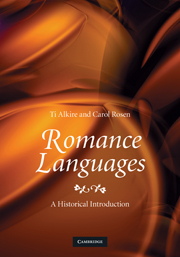Book contents
- Frontmatter
- Contents
- Acknowledgements
- Introduction
- 1 The evolution of stressed vowels
- 2 Early changes in syllable structure and consonants
- 3 Consonant weakening and strengthening
- 4 New palatal consonants
- 5 More about vowels: raising, yod effects, and nasalization
- 6 Verb morphology: the present indicative
- 7 Verb morphology: systemic reorganization
- 8 Noun and adjective morphology
- 9 History and structure of Portuguese: an overview
- 10 History and structure of Romanian: an overview
- 11 Formation of the Romance lexicon
- 12 Emergence of the Romance vernaculars
- Notes
- Glossary of linguistic terms
- Suggestions for further reading
- Works cited
- Index
12 - Emergence of the Romance vernaculars
Published online by Cambridge University Press: 05 June 2012
- Frontmatter
- Contents
- Acknowledgements
- Introduction
- 1 The evolution of stressed vowels
- 2 Early changes in syllable structure and consonants
- 3 Consonant weakening and strengthening
- 4 New palatal consonants
- 5 More about vowels: raising, yod effects, and nasalization
- 6 Verb morphology: the present indicative
- 7 Verb morphology: systemic reorganization
- 8 Noun and adjective morphology
- 9 History and structure of Portuguese: an overview
- 10 History and structure of Romanian: an overview
- 11 Formation of the Romance lexicon
- 12 Emergence of the Romance vernaculars
- Notes
- Glossary of linguistic terms
- Suggestions for further reading
- Works cited
- Index
Summary
Language in the Carolingian world
When do the Romance languages stop being Latin and become Romance? Here are two crude and unsatisfying answers. One is to posit some specific date. But whatever date you choose, there was obviously no sudden change in people's language behavior on that day or in that year or decade. Another answer, equally off target, is to dismiss the question as meaningless, claiming that since languages change continuously, no such break ever occurred. This is true but evasive. Let's restate the question: today there is something called French (Italian, Spanish, etc.), and once there wasn't. What changed, and when?
The question is better framed when we realize that what we are seeking is not the birth of any specific property internal to the phonology, grammar, or lexicon, but rather the birth of a cultural concept. The dawn of the Romance languages is not so much a linguistic change as a discovery, an innovation in people's thinking about their linguistic circumstances.
The key changes in these perceptions occurred in a period of several decades centered around the year 800. Our aim here is to see how the written record reveals people's experience of linguistic change.
The social setting
By the mid 700s, Western Europe was starting to materialize as a cultural zone. For the Romans, the Mediterranean Sea had been mare nostrum, the center of their world.
- Type
- Chapter
- Information
- Romance LanguagesA Historical Introduction, pp. 317 - 338Publisher: Cambridge University PressPrint publication year: 2010

